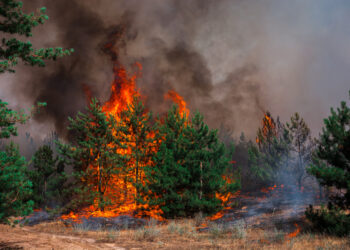By Kathleen Glockner EBS COLUMNIST
As winter covers everything from the mountain peaks to our front porches in a blanket of snow, Big Sky becomes the winter wonderland it’s famous for. Yet beneath the frosted trees and world-class powder is a rich landscape vulnerable to the harsh conditions of our beautiful winter and short summers. To withstand the region’s heavy snowfalls and freezing temperatures and prepare for the warmer months, our landscapes require proactive strategic planning. But first, you need to understand what challenges to address.
Understanding Winter Challenges
Recognizing Big Sky’s challenges can help develop a plan that supports a healthy landscape all year long.
Cold temperatures and heavy snow: Big Sky’s cold temperatures, heavy snow, and harsh winds can damage vulnerable vegetation and often result in broken branches, which can prevent spring growth. Young plants and perennials are especially susceptible to root damage.
Harsh winds: Our region’s cold winds can worsen dry conditions by stripping moisture from plants, a process known as desiccation. With frozen grounds preventing plant roots from absorbing water to replenish this loss, vegetation is vulnerable to stress and damage.
Snow removal and storage: Careful snow removal and storage planning will prevent snow and ice damage. Use gentle snow removal techniques to avoid harming the underlying vegetation, and store snow on hardscapes along your driveway in a location that doesn’t impede your entrance.
Wildlife grazing: The sparse winter foliage may cause nearby wildlife to graze on your vegetation in search of food. This can damage young trees and shrubs. To prevent this, install physical barriers around sensitive areas in need of protection.
Designing for Winter Viability
Here are some things you can do to design a resilient landscape.
Plant native: One of the best ways to preserve your landscape is to opt for native, fire-resistant, drought-tolerant plants that can withstand the cold, snow, and wind. Native plants have adaptations that allow them to weather Big Sky’s extreme temperatures and are less maintenance-intensive. Many native plants are also more fire resistant and can be incorporated into a fire-wise landscape, including stones, walkways – separation, and non-combustible ground cover (stone).
Protective structures: Employ protective structures such as windbreaks, mulch, and fabric plant covers to protect and shelter vulnerable plants from frost and snow. For example, inorganic mulch can keep roots from freezing and preserve moisture.
Irrigation systems: Winterize your irrigation system by shutting off the water supply, draining the pipes, and insulating the main valve, backflow preventers, and piping above ground. If you have an automatic sprinkler, turn off the timer or turn on rain mode.
Plant placement: Avoid planting in areas where snow accumulates, such as below roof edges, driveways, and where snow piles are stored after plowing. Instead, plants should be placed in shielded areas to maximize southern exposure (for sunlight) and minimize wind exposure from the north.
Hardscape: Durable hardscapes, such as paths, stepping stones, or concrete structures, not only add aesthetic value to your property but also effectively manage snow, drainage, and erosion. To prevent waterlogging, ensure that water drains away from plant roots and buildings by grading the soil.
Winter Care Plan
Maintaining a healthy outdoor space requires seasonal upkeep and maintenance.
It’s best to prune your trees and shrubs early winter before the snow sets in to avoid breakage and in late winter before spring growth starts.
Keep a close eye on accumulated snow on plant branches that can cause them to bend or break. Gently shake off snow accumulation on branches or shrubs, especially if they’re not flexible.
Lastly, it’s critical that you establish designated snow storage areas to protect the structural integrity of your landscape, minimize damage to sensitive ecological areas, maintain clear paths to your property, and minimize soil compaction.
By planning your landscape around Big Sky’s climate, alpine-appropriate plants, and protective features, you can create a beautiful, resilient landscape that thrives all year long. For more guidance on landscaping in Big Sky, visit Alpenscapes.org.
Alpenscapes is Big Sky’s go-to resource for creating appealing, alpine-appropriate landscapes that are fire-safe, water-wise, and ecosystem-friendly. Smarter landscapes. Thriving landscapes. Picturesque spaces.
Kathleen Glockner was born in Chicago but has always had a passion for the mountains. After relocating to Bozeman to attend Montana State University, she fell in love with the area and chose to stay. She now works with brands to elevate their marketing and content strategies.













